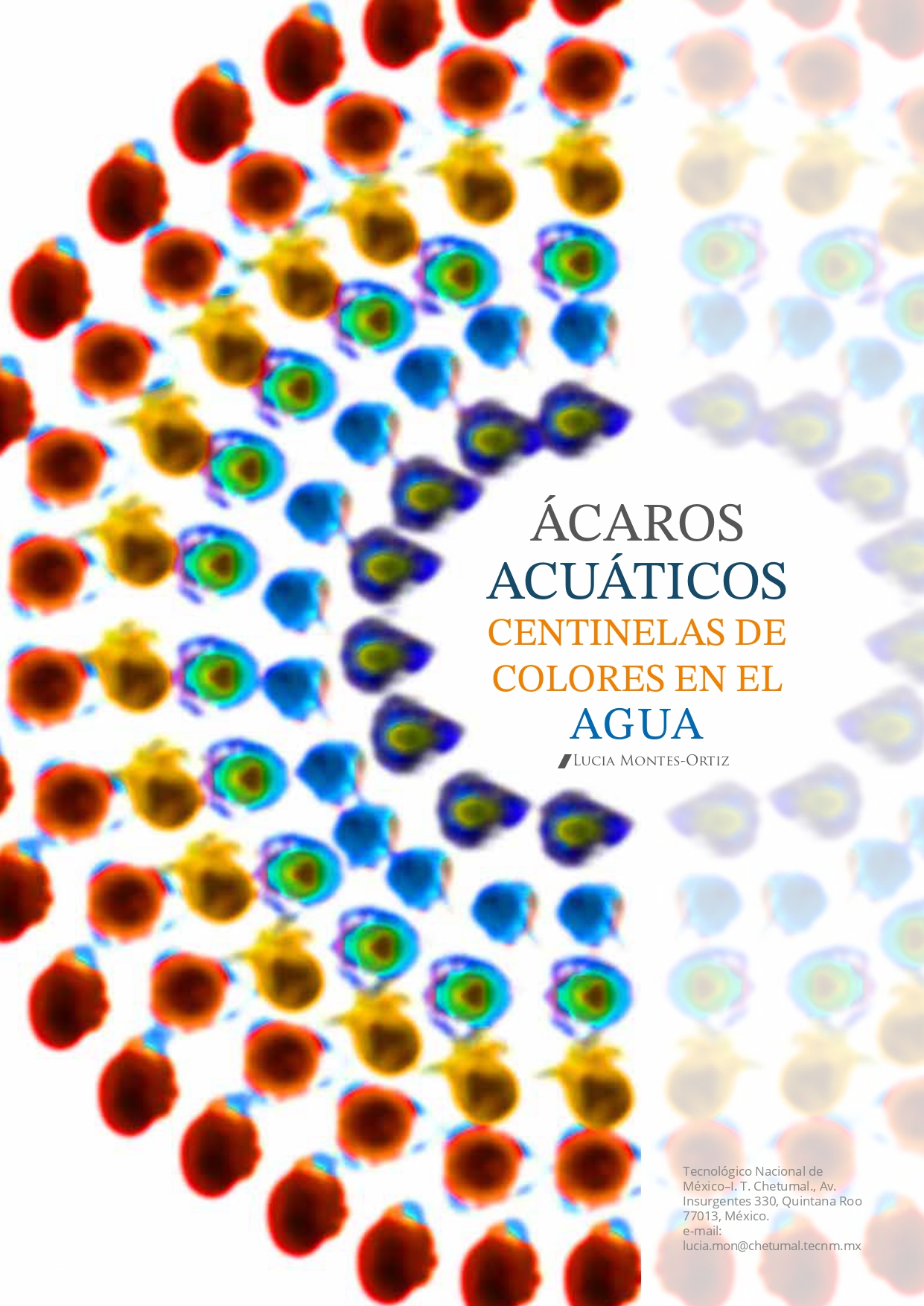Ácaros acuáticos
Centinelas de colores en el agua
DOI:
https://doi.org/10.29105/bys8.15-155Palabras clave:
Arácnidos, acuáticos, bioindicadores, diversidad, MéxicoResumen
Los ácaros acuáticos son los arácnidos más diversos y abundantes en los cuerpos de agua dulce, sin embargo, se trata de organismos desapercibidos y subestimados tanto en la sociedad como en los campos de investigación. Este escrito tiene como objetivo principal brindar generalidades en la morfología, ciclo de vida, reproducción e importancia de los ácaros acuáticos en el ecosistema que habitan, así como su potencial en la conservación de los cuerpos de agua. Asimismo, se detalla el estado de conocimiento de estos organismos en el país
Descargas
Citas
Balian, E.V., Segers, H., Lévèque, C., Martens, K. 2008. The Freshwater Animal Diversity Assessment: an overview of the results. Hydrobiologia. 595:627–637 DOI: https://doi.org/10.1007/s10750-007-9246-3
Cassano, C.R., M.S.M. Castilho-Noll, M.S. Arcifa. 2002. Water mite predation on zooplankton of a tropical lake. Brazilian Journal of Biology. 62(4 A): 565-571. DOI: https://doi.org/10.1590/S1519-69842002000400002
Chatterjee, T., Schizas, N., Pésic, V. 2019. A checklist of Pontarachnidae (Acri: Hydrachnidia) and notes on distributional patterns of the species. Zootaxa. 3: 527-544. DOI: https://doi.org/10.11646/zootaxa.4619.3.6
Cook, D.R. 1980. Studies on neotropical water mites. Memoirs of the American Entomological Institute. p. 645.
Di Sabatino, A., Smit, H., Gerecke, R., Goldschmidt, T., Matsumoto, N., Cicolani, B. 2008. Global diversity of water mites (Acari, Hydrachnidia, Arachnida) in freshwater. Hydrobiologia. 595: 303-315. DOI: https://doi.org/10.1007/s10750-007-9025-1
Gliwicz, Z.M., E. Biesiadka. 1975. Pelagic water mites (Hydracarina) and their effect on the plancton community in a Neotropical man-made lake. Arch für Hydrobiologie. 76:65-88.
Goldschmidt T. 2016. Water mites (Acari: Hydrachnidia): powerful but widely neglected bioindicators -a review. Neotropical Biodiversity 2:12-25 DOI: https://doi.org/10.1080/23766808.2016.1144359
Goldschmidt T., J. Schmidt, E. Boles. 2022. Hidden treasures – a first study on the unexplored diversity of water mites (Acari; Hydrachnidia) from Belize. Acarologia 62(3): 694-720. DOI: https://doi.org/10.24349/vk99-cldq
Manges, A. B., T. W., Simmons, M. L., Hutchinson. 2018. First Record of Aedes albopictus (Diptera: Culicidae) and Second Record of Aedes japonicus (Diptera: Culicidae) Parasitized by Water Mites (Acari: Hydrachnidiae) in North America. Journal of medical entomology, 55(6), 1617–1621. https://doi.org/10.1093/jme/tjy105 DOI: https://doi.org/10.1093/jme/tjy105
Martin, P., R. Gerecke R. 2009. Diptera as hosts of water mite larvae—an interesting relationship with many open questions. Lauterbornia 68:95–103.
Montes-ortiz, L., Elías-Gutiérrez M. 2018. Faunistic survey of the zooplankton community in an oligotrophic sinkhole, Cenote Azul (Quintana Roo, Mexico), using different sampling methods, and documented with DNA barcodes. Journal of Limnology. 77(3): 428 - 440. DOI: https://doi.org/10.4081/jlimnol.2018.1746
Montes-Ortiz, L., M. Elías-Gutiérrez. 2020. Water Mite Diversity (Acariformes: Prostigmata: Parasitengonina: Hydrachnidiae) from Karst Ecosystems in Southern Mexico: A Barcoding Approach. Diversity, 12 (329), 1-16. DOI: https://doi.org/10.3390/d12090329
Montes-Ortiz, L., M. Elías-Gutiérrez, M., M. Ramírez-Sánchez. 2022. Checklist of Arrenurids (Acari: Hydrachnidia: Arrenuridae) of Mexico, with New Records from the Yucatan Peninsula, and the Description of Five New Species of the Subgenera Megaluracarus and Dadayella. Diversity, 14(4), 276. https://doi.org/10.3390/d14040276 DOI: https://doi.org/10.3390/d14040276
Montes-Ortiz, L., Cohuo, S., M. Elías-Gutiérrez. Checklist of water mites in Mexico. Historical background and DNA barcoding perspectives. Acarologia, 64 (2), 612- 625. https://doi.org/10.24349/ah6q-r1rk DOI: https://doi.org/10.24349/ah6q-r1rk
Paterson, C.G. 1970. Water mites (Hydracarina) as predators of chironomid larvae (Insecta: Diptera). Canadian Journal of Zoology. 48:610-14. DOI: https://doi.org/10.1139/z70-112
Proctor, H. 1992. Mating and spermatophore morphology of water mites (Acari: Parasitengona). Zoological Journal of the Linnean Society. 106: 341-384 DOI: https://doi.org/10.1111/j.1096-3642.1992.tb01250.x
Proctor, H., G. Pritchard. 2008. Neglected predators: water mites (Acari: Parasitengona: Hydrachnellae) in freshwater communities. Journal of the North American Benthological Society. 8(1): 100-111. DOI: https://doi.org/10.2307/1467406
Proctor, H.C., I.M Smith, D.R. Cook, B.P. Smith. 2015. Subphylum Chelicerata. Class Arachnida. In: Thorp J, Rogers DC, editors. Ecology and General Biology: Thorp and Covich ́s Freshwater Invertebrates, Academic Press. p. 599-660. DOI: https://doi.org/10.1016/B978-0-12-385026-3.00025-5
Rivas, G. y A. Hoffmann. 2000. Los ácaros acuáticos de México. Estado actual de su conocimiento. Mexicoa. 2:33-39.
Sánchez, M.I., Coccia, C., Valdecasas, A.G. et al. Parasitism by water mites in native and exotic Corixidae: Are mites limiting the invasion of the water boatman Trichocorixa verticalis (Fieber, 1851). Journal of Insect Conservation 19, 433–447 (2015). https://doi.org/10.1007/s10841-015-9764-7 DOI: https://doi.org/10.1007/s10841-015-9764-7
Smith, I. M., D. R. Cook, Smith, B. P. 2001. Water mites (Hydrachnida) and other arachnids. In Thorp J. H. & A. P. Covich (eds), Ecology and Classification of North American Freshwater Invertebrates (2nd edition). Academic Press, San Diego, California, 551–659. DOI: https://doi.org/10.1016/B978-012690647-9/50017-X







